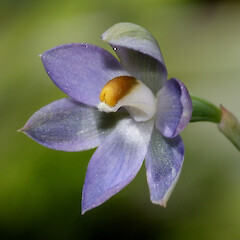Thelymitra colensoi
Common name
Colenso’s sun orchid
Synonyms
Thelymitra intermedia Berggr.
Family
Orchidaceae
Flora category
Vascular – Native
Endemic taxon
Yes
Endemic genus
No
Endemic family
No
Structural class
Orchids
NVS code
The National Vegetation Survey (NVS) Databank is a physical archive and electronic databank containing records of over 94,000 vegetation survey plots - including data from over 19,000 permanent plots. NVS maintains a standard set of species code abbreviations that correspond to standard scientific plant names from the Ngä Tipu o Aotearoa - New Zealand Plants database.
THECOL
Current conservation status
The conservation status of all known New Zealand vascular plant taxa at the rank of species and below were reassessed in 2017 using the New Zealand Threat Classification System (NZTCS) – more information about this can be found on the NZTCS website. This report includes a statistical summary and brief notes on changes since 2012 and replaces all previous NZTCS lists for vascular plants.
Please note, threat classifications are often suggested by authors when publications fall between NZTCS assessment periods – an interim threat classification status has not been assessed by the NZTCS panel.
- Conservation status of New Zealand indigenous vascular plants, 2017 . 2018. Peter J. de Lange, Jeremy R. Rolfe, John W. Barkla, Shannel P. Courtney, Paul D. Champion, Leon R. Perrie, Sarah M. Beadel, Kerry A. Ford, Ilse Breitwieser, Ines Schönberger, Rowan Hindmarsh-Walls, Peter B. Heenan and Kate Ladley. Department of Conservation. Source: NZTCS and licensed by DOC for reuse under the Creative Commons Attribution 4.0 International licence.
2017 | Data Deficient
Previous conservation statuses
2012 | Data Deficient
2009 | Not Threatened
2004 | Not Threatened
Distribution
Endemic. New Zealand: Manawatāwhi / Three Kings Islands, North Island, South Island, Stewart Island/Rakiura. Rather widespread and very common in northern New Zealand. Often on offshore islands.
Habitat
Coastal to montane (up to 700 m a.s.l.). Usually in open ground, or on clay pans. Frequent in successional shrublands and open forest. Common in pine plantations. Together with members of the T. longifolia J.R.Forst. et G.Forst. agg, this is the most commonly encountered sun orchid on northern offshore islands. Frequently found growing with T. pauciflora R.Br.
Detailed description
Terrestrial, tuberous, glabrous late winter to summer-green perennial herb. Leaf solitary, erect, to suberect, or trailing on ground, fleshy, deeply channelled and keeled, prominently v-shaped in cross section, 80–300 × 3–6–(8) mm, dark or light green base, linear-lanceolate to lanceolate, apex acute, margins and upper and lower surfaces often spotted with rust, closely sheathing at base. Inflorescence racemose, 80–300 × 1–1.5–(2.5) mm, slender, straight, wiry, dark green, reddish green or yellow-green. Bracts 1–2–(3), 10–30 × 3–4 mm, linear to linear-lanceolate, closely sheathing, acute to acuminate, dark green or reddish green. Flowers 1–7, 10–15 mm diameter, pale blue, mauve to pink; only opening on very hot, still, sunny days, autogamous. Perianth segments 6–8 × 3–5 mm, concave, shortly apiculate; dorsal sepal lanceolate to ovate, obtuse to subacute; lateral sepals lanceolate to ovate, acute; petals broadly lanceolate to ovate, subacute; labellum elliptic to lanceolate, acute, slightly smaller than other segments. Column 3.5–4.2 × 2.0–2.5 mm, erect, pale blue to mauve; post-anther lobe slightly cucullate and curved, usually dark brown to reddish-brown or red, apex bluntly entire, bright yellow; post-anther lobe extension minute; auxillary lobes absent; column arms converging, 0.5-0.8 mm long, bent sharply upwards near the middle at 90 degrees, each furnished with a subterminal tuft of sparse white cilia. Anther inserted above central column. Stigma situated at base of column.
Manaaki Whenua Online Interactive Key
Similar taxa
Thelymitra colensoi is rather similar to and often confused with T. pauciflora R.Br.. However, T. colensoi, is an endemic species which is much smaller and more slender, with fewer flowers (up to 5), which almost never open, and then only one at a time. The flowers are certainly autogamous and probably also cleistogamous. The petals are pale blue to pale pink. The post-anther lobe is not as thin or as deeply inturned as T. pauciflora, pale blue to pink, grading through brown to reddish-brown with a pale yellow to yellow margin. The post-anther lobe is rather similar to that of T. longifolia G.Forst. though much more deeply cleft. Thelymitra colensoi is often known in New Zealand by its later synonym T. intermedia Berggren.
Flowering
July–December
Flower colours
Red/Pink, Violet/Purple
Fruiting
September–March
Propagation technique
Very easily grown in a sunny, well drained site. Often naturalises in gardens within urban areas abutting indigenous vegetation in northern New Zealand. This species is a common contaminant of pine bark and is often found growing within inner city traffic islands and planter boxes in which pine bark mulch has been strewn. Although easily cultivated, like all orchids it should not be removed from the wild.
Etymology
thelymitra: Woman’s hat
colensoi: Named after William Colenso (7 November 1811 - 10 February 1899) who was a Cornish Christian missionary to New Zealand, and also a printer, botanist, explorer and politician.
Attribution
Fact Sheet prepared for NZPCN by P.J. de Lange 14 April 2007. Description subsequently published in Rolfe & de Lange (2010).
References and further reading
Rolfe JR, de Lange PJ. 2010. Illustrated guide to New Zealand sun orchids, Thelymitra (Orchidaceae). Jeremy Rolfe, Wellington, NZ. 57 p.
NZPCN Fact Sheet citation
Please cite as: de Lange, P.J. (Year at time of access): Thelymitra colensoi Fact Sheet (content continuously updated). New Zealand Plant Conservation Network. https://www.nzpcn.org.nz/flora/species/thelymitra-colensoi/ (Date website was queried)

















